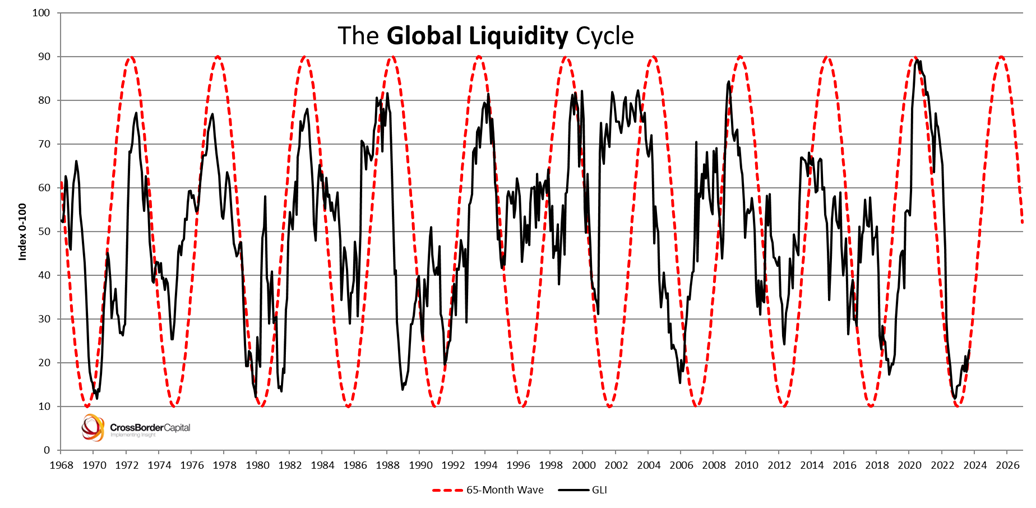Global Liquidity and Bitcoin
Episode XXIII. Block Height: 864800. What drives global liquidity, where we are at the global liquidity cycle, and how does it impact Bitcoin's price?
The global liquidity cycle dances like a tide, ebbing and flowing through the veins of the world's economies, each wave of capital leaving its mark on the shores of scarce assets. Bitcoin, a digital ember born from the fire of innovation, flickers brighter when the tide is high, nourished by the abundance of liquidity that sweeps across the financial landscape. Yet, when the tide recedes and the waters of capital retreat, Bitcoin stands resilient over time, its fixed supply like a beacon in the storm, a silent testament to the enduring power of scarcity in a world awash with excess.
Liquidity in an interconnected world is not isolated to one region or country, it is global in nature, and central banks are right at the center. The decisions made by these major central banks around the world have ripple effects. This interconnection means that in a fiat-measured world, global liquidity is a crucial determinant of asset prices, economic growth, and volatility. In this context, it's essential to understand the Global Liquidity Cycle, the players involved and if/how it correlates with Bitcoin. This is what this episode is all about. Strap in and LFG!
The Liquidity Cycle
First and foremost, in a world ruled by the money printer, periods of abundant liquidity often coincide with economic booms and rising asset prices, but they also tend to foster speculative bubbles and financial instability. When liquidity tightens, these bubbles can burst, leading to market corrections or even economic crises. This flow is a repeating pattern and can be characterized by the concept of the liquidity cycle.
Liquidity Expansion
In the expansion phase of the Global Liquidity Cycle, central banks and financial institutions provide abundant liquidity. This often occurs during periods of low inflation, low interest rates, and loose monetary policies. Central banks inject liquidity through quantitative easing (QE), asset purchases, and lowering policy rates, while commercial banks and non-bank financial institutions extend credit more freely. During this phase, capital becomes widely available and cheap. Investors and corporations take on more risk, seeking higher returns in equities, commodities, real estate, and emerging markets. Asset prices tend to rise, and speculative investments flourish as liquidity searches for yield. Economies grow as consumption and investment are fueled by easy access to capital. However, excess liquidity can lead to asset bubbles as investors pile into riskier investments, driving prices above their fundamental values. The potential for financial imbalances increases as markets become overly dependent on the flow of liquidity.
Peak Liquidity
At the peak of the liquidity cycle, global markets are flush with cheap money, and central banks begin to signal the need for tighter monetary policies due to concerns over inflation and financial instability. During this stage, asset prices are typically at their highest, driven by the abundance of liquidity. Investors and institutions may become complacent, underestimating the risks in financial markets because of the prolonged period of low interest rates and high liquidity. This phase is marked by heightened risk-taking, speculative activity, and the growing risk of financial bubbles.
Liquidity Contraction
The contraction phase begins when central banks tighten monetary policy, often in response to rising inflation, overheating economies, or concerns about financial instability. Central banks reduce asset purchases, raise interest rates, or shrink their balance sheets, leading to a withdrawal of liquidity from the financial system. Commercial banks may also tighten lending standards, leading to reduced credit availability. As liquidity contracts, borrowing costs increase, and access to capital becomes more difficult. This leads to a sell-off in “riskier” assets as investors retreat to “safer” assets like government bonds or cash. Asset prices fall, and the economy may slow as investment and consumption are constrained by higher borrowing costs.
Trough
At the trough, liquidity is at its most scarce. Central banks have significantly tightened monetary conditions, interest rates are high, and credit is difficult to access. Financial markets experience widespread deleveraging, asset prices are depressed, and economies may enter a recession. However, this phase also sets the stage for the next liquidity expansion. As economies weaken and inflationary pressures subside, central banks begin to ease monetary policy again to stimulate growth, lowering interest rates and providing more liquidity to the financial system. This initiates the next cycle of liquidity expansion.
M2 Money Supply
The M2 money supply is the primary driver of the Global Liquidity Cycle, which measures the total amount of money circulating within an economy. It includes M1, which consists of the most liquid forms of money like cash and checking deposits, as well as less liquid assets such as savings accounts, money market mutual funds, and time deposits. M2 is considered a broader measure than M1 because it accounts for money that is not immediately available for spending but can easily be converted into cash.
The world M2 money supply just hit a fresh new ATH of roughly $95 trillion in August, even before central banks started their rate-cutting and QE cycles. China just announced its most aggressive stimulus package since the pandemic, and the FED lowered rates by 50 bps. Liquidity expert Michael Howell came to the conclusion that we're currently at the beginning of a new upswing. The last trough occurred in December 2022, with the next peak projected for the end of 2025.
Infinite Liquidity Glitch
Central Banks
Major driver of the M2 money supply are central banks manipulating the market through monetary policies such as interest rate adjustments, and open market operations. When central banks lower interest rates, borrowing becomes cheaper for businesses and consumers, encouraging more loans and credit creation. This increased borrowing adds to the money circulating in the economy, thus expanding M2. Conversely, raising interest rates makes borrowing more expensive, slowing down the creation of credit and contracting the M2 supply. Additionally, central banks engage in open market operations purchasing large amounts of government bonds to stabilize interest rates or finance fiscal deficits. This process, known as "monetizing the debt," increases bank reserves and creates more liquidity in the financial system. As a result, banks have greater capacity to lend, further expanding the M2 supply. If these new loans are used for consumption or investment, the money circulates through the economy, amplifying the impact of government debt refinancing on overall money supply growth. Over time, repeated cycles of refinancing, coupled with central bank involvement, contribute to a sustained increase in the money supply.
Government Debt
Refinancing growing government debts, or rolling over maturing debt, has a direct impact on M2. When governments issue new bonds to repay or refinance maturing debt, they effectively keep the level of public borrowing constant or, most of the time, substantially increase it. This process often requires financial institutions, investors, or central banks to purchase the new bonds, injecting liquidity into the economy. As financial institutions buy these government securities, they create new deposits in the banking system, contributing to the expansion of the M2 money supply. The continual issuance of government bonds ensures that money remains in circulation as bondholders receive regular interest payments and returns of principal, which increases the funds available for spending, investment, and further lending. As banks receive more deposits, they also gain the ability to lend more, which can further expand the money supply through the money multiplier effect. Global public debt reached close to $100 trillion at the end of 2023, and there is no sign of stopping this train. On the contrary.
Endless Wars
War in Ukraine, war in the Middle East, trade war with China, war everywhere and that is no coincidence. Fiat currencies promote perpetual wars because they can be financed simply by printing money, and the true burden on the population only becomes apparent in the long term. Thus, war significantly impacts a country's M2 money supply. To fund military operations and war-related expenses, governments resort to expanding the money supply by issuing more government bonds, which in turn get monetized by central banks. This process increases the overall M2 supply as central banks inject liquidity into the economy to meet rising demand for funds.
Bitcoin and Liquidity
Bitcoin operates outside the conventional financial system. It was created in response to concerns about inflation and the ability of central banks to expand the money supply at will, which can erode the value of traditional fiat currencies, as mined for eternity in the genesis block: “The Times 03/Jan/2009 Chancellor on brink of second bailout for banks.” Bitcoin’s supply is capped at 21 million coins, creating a built-in scarcity that contrasts sharply with the potentially unlimited expansion of the M2 money supply. Thus, one Bitcoin will always be one Bitcoin, regardless of the actions of central banks and governments. However, hyperbitcoinization, where everything is measured against Bitcoin, is still in the making, and we still live in a world measured in fiat currencies, so global liquidity will influence the Bitcoin price for the foreseeable future.
The correlation between Bitcoin and the M2 global money supply is striking and more pronounced during periods of aggressive monetary expansion, where central banks around the world inject vast amounts of liquidity into the financial system. Bitcoin's correlation with the M2 supply highlights a broader tension between centralised monetary systems and scarce decentralised financial technologies. As central banks continue to expand the money supply in response to economic challenges and financing ever-growing debt loads, Bitcoin will continue to rise.
Furthermore, the correlation between M2 and Bitcoin is also amplified by speculative behavior in financial markets. Bitcoin is still seen by most market participants as a risky asset. Thus, when the money supply grows and liquidity is abundant, the risk appetite among investors tends to increase. Bitcoin becomes a focal point for traders and investors seeking gains in a low-interest-rate environment. This speculative activity can further fuel price appreciation during periods of M2 expansion. The greater the availability of currency in the economy, the more capital is available to flow into risky assets, creating a feedback loop that drives up prices.
Conclusion
Unfortunately, hyperbitcoinization is not here yet, and we still live in a world measured in fiat currencies. The strong correlation between Bitcoin and the M2 money supply is striking. In times of abundant liquidity, Bitcoin rises significantly, while in times of tightening, it often enters a new bear market. However, inherent to the fiat currency system is the expansion of the M2 money supply over time because governments aren‘t going to stop spending. Thus, central banks can’t stop printing to finance increased debt levels and ever-increasing interest rate payments, which further increases the M2 money supply. This means that absolutely nothing is going to stop the devaluing fiat currency train over time while scarce assets increase to infinity. Bitcoin is the fastest horse in the race, soaking up huge amounts of this liquidity. Prepare yourself accordingly.
The End
That's it for this episode. I hope you got some valuable information from this one. Don’t forget: There are only 21 million Bitcoin forever, but unlimited fiat currency! Thanks for reading, and see you in the next one. ₿ critical, ₿ informed, ₿ prepared.
Yours,
Education for everyone
Pure, independent and free education. If you want to support my work, you can donate Sats via Lightning. I truly appreciate it!
Not your keys, not your coins
Get yourself a proper hardware wallet: The Bitbox Bitcoin-only! is my favourite. Swiss made, Great customer support and worldwide shipment.
Education is key
[1] Michael J. Howell, The Rise of Global Liquidity
[2] Adam LeBor, Tower of Basel
[3] Ray Dalio, Big Debt Crisis
[4] Sebastian Bunney, The Hidden Cost of Money
[5] Joseph J. Wang, Central Banking 101











Excellent analysis!
Hopefully you might open the eyes of some sleeping sheep!
amazing read!